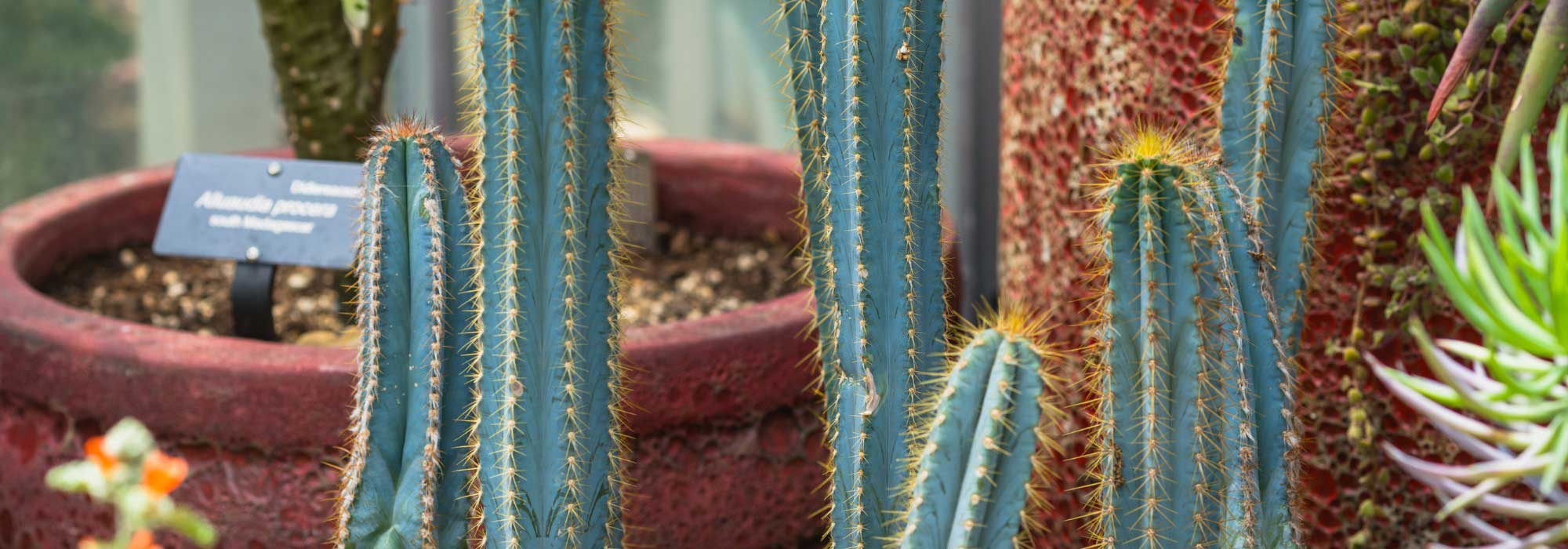
Pilosocereus: planting, growing, and caring for
Contents
Pilosocereus in a nutshell
- Pilosocereus is a remarkable columnar cactus with ribbed stems that have blue-green or turquoise hues.
- It is a relatively fast-growing cactus, capable of reaching heights of up to 2 or 3 m in a pot.
- Not very hardy, it is ideally grown in a pot indoors, but it can also be placed outside on the terrace during summer, to be brought back inside before autumn.
- Sculptural and easy to care for, it makes an excellent ornamental subject on a terrace, in a conservatory, or in a bright indoor space.
- It enjoys a very sunny position and a perfectly drained substrate.
A word from our expert
The Pilosocereus is a highly decorative columnar cactus, native to tropical regions of America. With its upright stems of often vibrant blue-green, sometimes even turquoise, adorned with characteristic wooly hairs (hence its name derived from the Latin pilosus, meaning “hairy”), this cactus instantly creates a very exotic atmosphere. It evokes the desert landscapes of Latin America, and in our latitudes, it easily finds its place in well-lit interiors.
The Pilosocereus is especially valued for its highly graphic appearance, its relatively rapid growth for a columnar cactus, and its ability to produce magnificent flowers. It belongs to the large family of Cactaceae and stands out not only for its aesthetics but also for its robustness and ease of care — a true boon for both exotic plant enthusiasts and succulent lovers.
In this article, we will explore in detail the botanical specifics of the Pilosocereus, its most popular varieties, the best ways to plant and care for it, as well as tips for propagating and showcasing it.
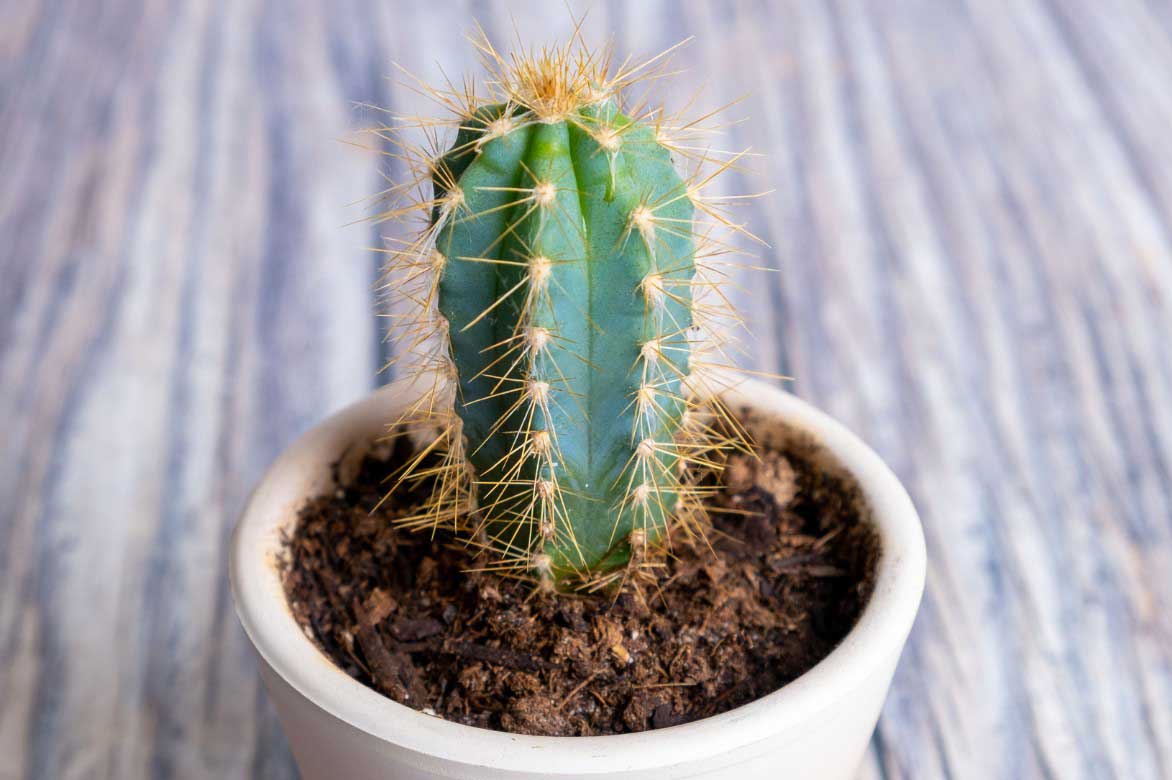
Pilosocereus pachycladus
Description and Botany
“`html
Botanical data
- Latin name Pilosocereus sp.
- Family Cactaceae
- Common name Pilosocereus, Blue Torch Cactus
- Flowering Generally in summer / early autumn
- Height Up to 2 or 3 m
- Sun exposure Full sun
- Soil type Well-drained, sandy
- Hardiness Frost-sensitive. Between -4 °C and 10 °C depending on the species
The Pilosocereus is a genus of columnar cactus primarily native to Central America, the Caribbean, and South America, with a notable presence in Brazil, Mexico, and the Antilles. This majestic cactus thrives in arid and semi-arid environments, often on rocky terrain or at altitude, where it benefits from intense sunlight and excellent drainage.
The name Pilosocereus comes from Latin: it is formed from “pilosus”, meaning “hairy” or “covered in hairs”, and “cereus”, a botanical term used to refer to columnar cacti. Literally, Pilosocereus means “hairy columnar cactus”, directly referencing the very visible woolly areoles that cover its ribs, often white or yellow depending on the species.
Like all cacti, the Pilosocereus has a unique metabolism that allows it to adapt to an arid environment: its swollen stems enable it to store water and minerals. The absence of leaves, replaced by thorns, helps to limit evaporation and thus water loss. Its heavily ribbed stems create shaded areas, providing shelter from the sun.
The Pilosocereus is distinguished by its upright and branched habit, forming vertical columns that can reach several metres high in its natural habitat — sometimes up to 10 metres! When cultivated in pots in our latitudes, it remains much more modest, but can still reach 1 to 3 metres in height over time.
Its stems are ribbed, often blue-green to turquoise, making it one of the chromatic rarities in the plant world. The ribs are adorned with small fluffy areoles, from which emerge thorns of varying lengths and white or yellow woolly hairs, particularly visible in certain species. This is the case, for example, with Pilosocereus leucocephalus, whose ribs are covered with abundant white wool. This feature helps the cactus protect itself from the scorching sun and drought by reflecting sunlight.
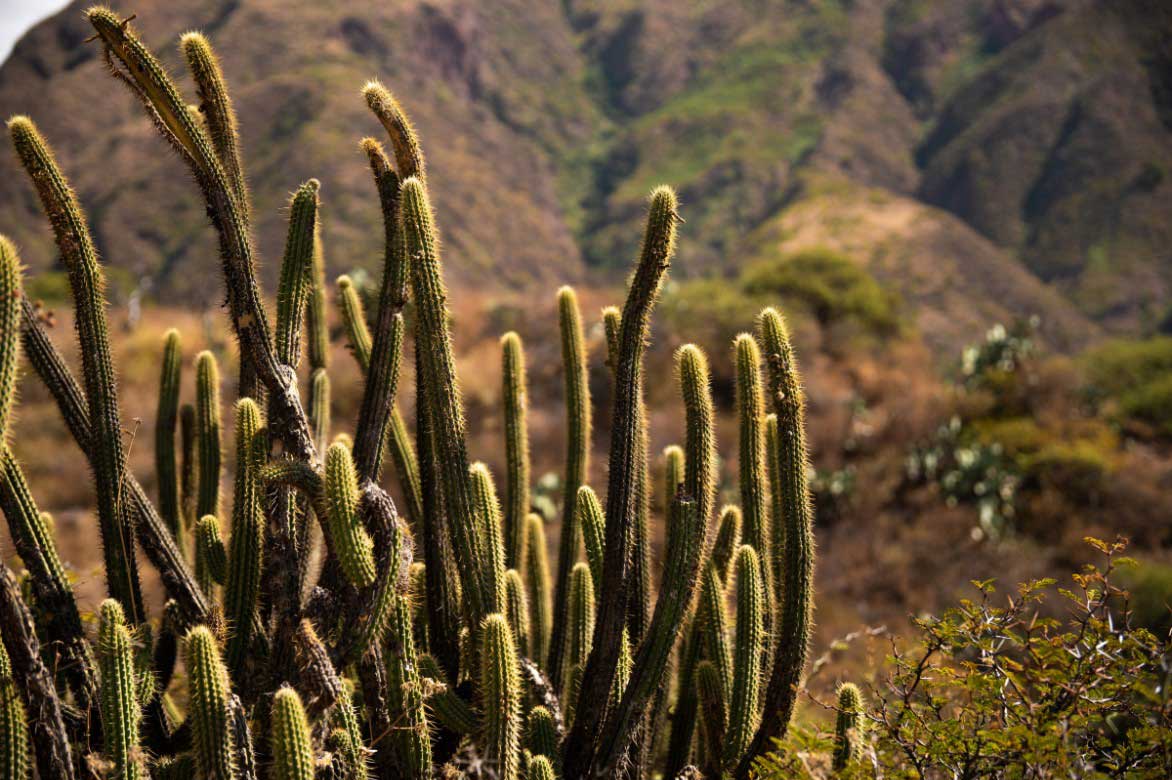
Pilosocereus tillianus
The Pilosocereus also offers a stunning flowering display. Its flowers are often large, tubular, white or cream, sometimes tinged with pink. In its natural habitat, they are primarily pollinated by bats, which is why they bloom at night. After flowering, round, colourful fruits may appear. They typically have dark pink or magenta flesh and contain numerous small black seeds. Some species, such as Pilosocereus gounellei, produce edible fruits.
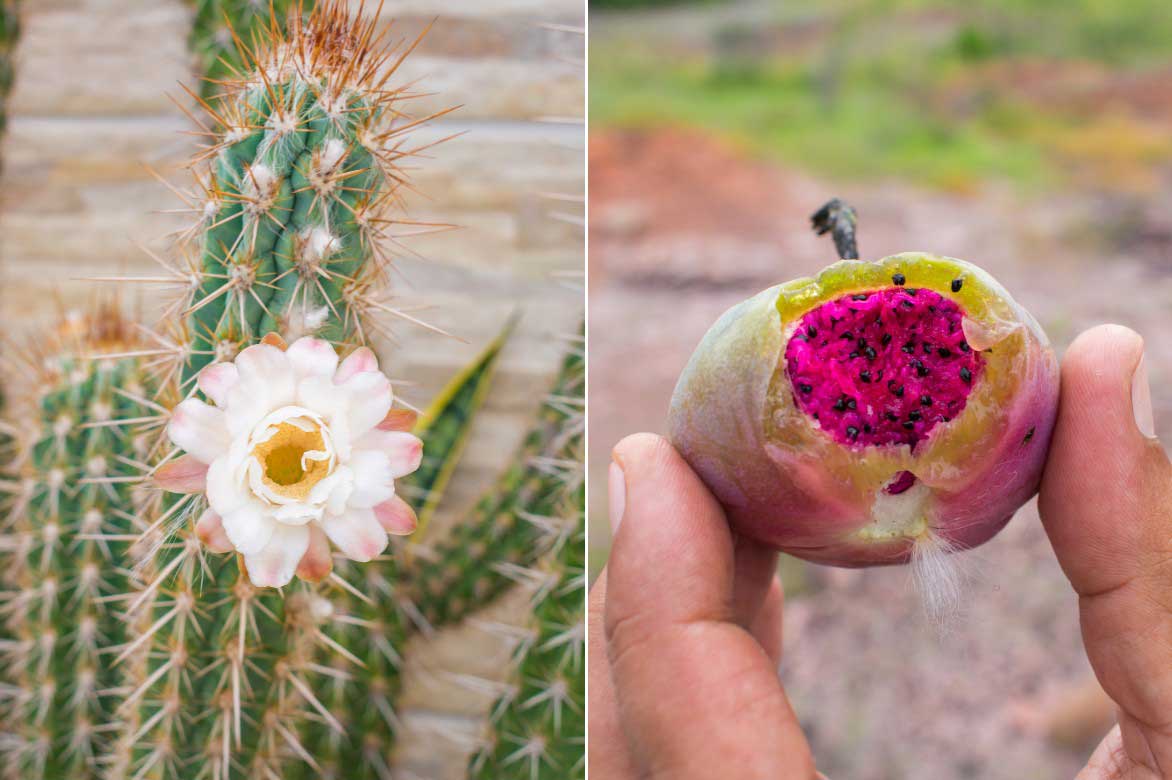
Flower and fruit of Pilosocereus gounellei
The genus Pilosocereus comprises over 50 species, all native to tropical and subtropical regions of America. These columnar cacti are distinguished by their majestic habit, ribbed stems often with bluish hues, and areoles adorned with woolly hairs. Here are some of the most remarkable species:
- Pilosocereus pachycladus : Often referred to as the “blue cactus of Brazil” or “Blue Torch Cactus”, it is a spectacular variety of columnar cactus, prized for its unique silvery-blue hue and upright habit. Native to northeastern Brazil, this species can reach up to 10 metres in height. Its blue-green stems feature marked ribs and translucent thorns that change from golden yellow to grey with age. The flowers, measuring 4 to 7 cm long, give rise to spherical fruits with magenta flesh. It is also found under the name Pilosocereus azureus.
- Pilosocereus leucocephalus : Known as the “white-headed cactus”, it is native to Mexico, Guatemala, and Honduras. This cactus is characterised by its areoles abundantly covered with white hairs and its white or pink flowers.
- Pilosocereus gounellei : Endemic to Brazil, this species has a candelabra-like shape, with branches starting from the base. It is adapted to semi-arid regions.
- Pilosocereus royenii: Found in the Antilles and Mexico, this tree-like cactus with tubular stems is commonly known as the dildo cactus or pipe organ cactus. It is appreciated for its imposing habit and tolerance to coastal conditions.
The Pilosocereus is a tropical and subtropical cactus: it is sensitive to frost. Its hardiness is generally limited to -2°C for short periods, and only if the soil is perfectly dry. In regions with a mild climate, such as the Mediterranean coast where frost risk is very low, it can be grown outdoors all year round; elsewhere, it should be grown in pots to be brought indoors in winter. It requires maximum light and prefers full sun exposure.
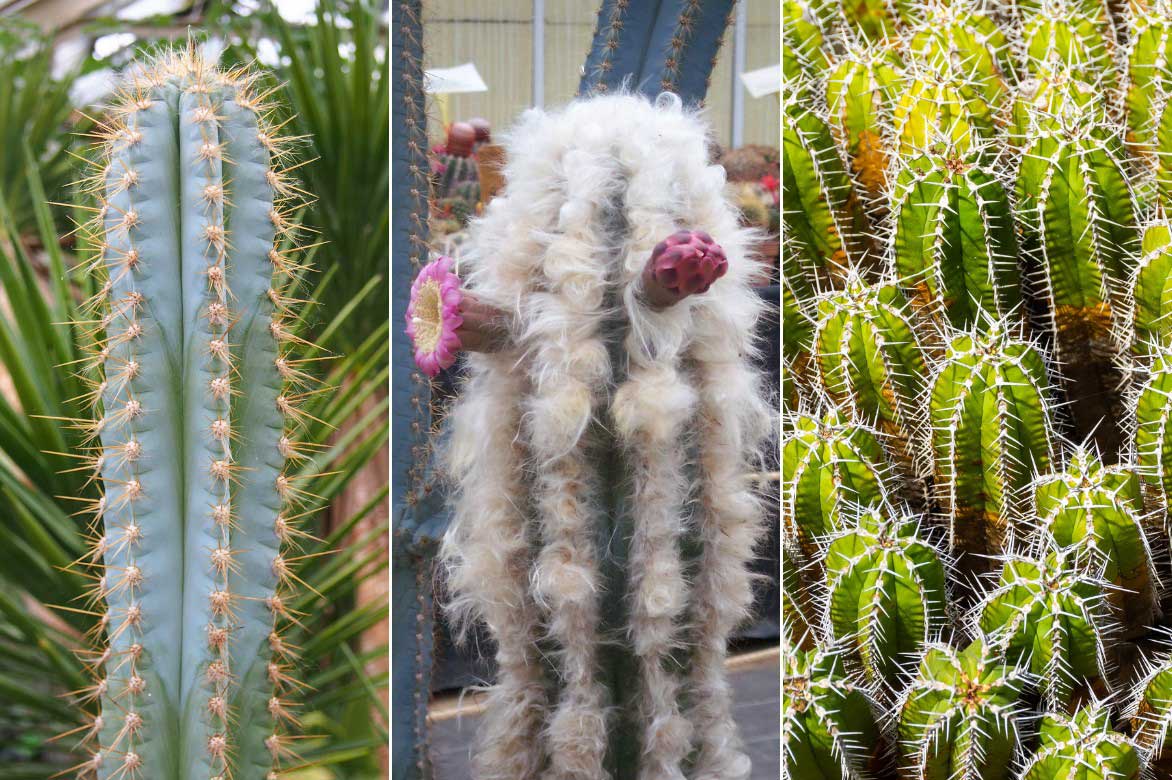
There are many species of Pilosocereus! Here, Pilosocereus pachycladus, Pilosocereus leucocephalus, and Pilosocereus royenii
“`
The main species and varieties
Planting Pilosocereus
Where to Install the Pilosocereus?
This cactus requires excellent light, as it loves the sun! It should be placed in full sun to develop its beautiful blue hue and grow harmoniously. Indoors, position it near a south or west-facing window, and avoid dark corners where it may become leggy.
You can place the pot outside in summer, in full sun. Bring it back inside as soon as night temperatures drop below 10 °C. It will appreciate a conservatory, a cold greenhouse, or a very bright, unheated room.
In a Mediterranean climate, it can be planted directly in the ground, provided the soil is perfectly drained. Elsewhere, pot cultivation is preferable, allowing it to be brought in from frost during winter.
When to Plant?
The ideal time to plant or repot the Pilosocereus is in spring, when temperatures are relatively mild. This season offers it the perfect conditions to restart its growth after the winter dormancy.
We recommend repotting it every two to three years, when the roots have filled the pot or the substrate has compacted or depleted. Fresh substrate and an appropriate container will encourage quick and vigorous recovery.
How to Plant?
Install your Pilosocereus in a deep, well-drained pot, which must have drainage holes at the bottom. A terracotta container is recommended: it promotes moisture evaporation and stabilises the plant due to its weight.
Use a very draining substrate, which prevents any water stagnation around the roots. A homemade mix works very well: 1/3 cactus compost, 1/3 coarse sand (or pumice), and 1/3 perlite or small gravel.
- Place a drainage layer (clay balls or gravel) 3 to 5 cm deep at the bottom of the pot to improve drainage.
- Then add some well-draining substrate to the pot.
- Gently remove the Pilosocereus from its original pot. We recommend using gloves to protect yourself from the thorns.
- Position the root ball in the centre of the new pot, without compacting the substrate too much.
- Keep the plant dry for 4 to 7 days before the first watering. This delay allows any root injuries to heal and limits the risk of rot.
Avoid saucers filled with water and only water when the substrate is thoroughly dry. Once well established, the Pilosocereus requires very little maintenance, provided it is in the sun and protected from winter moisture.
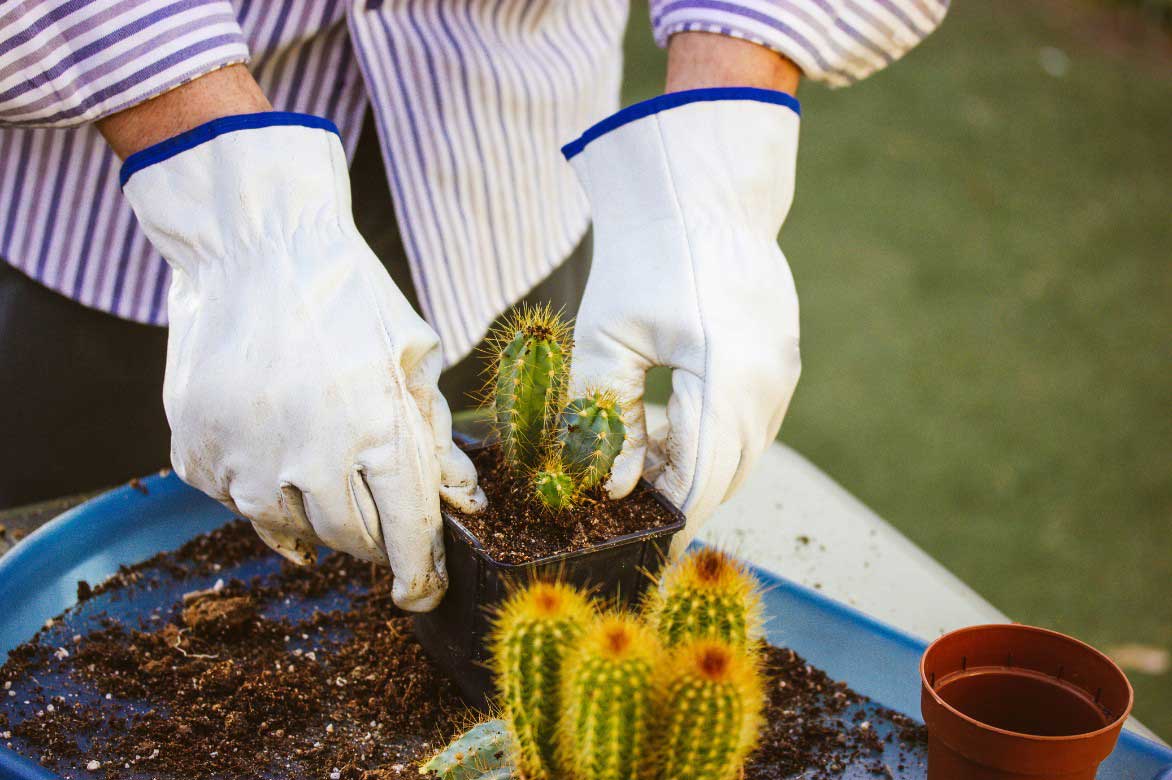
Repot the Pilosocereus in a well-draining substrate, and use gloves to avoid injury from the thorns!
How to care for Pilosocereus?
Watering
Like all cacti, Pilosocereus hates excess water. Overwatering is the main cause of mortality for this plant. In spring and summer, water it moderately, about every 10 to 15 days, only when the substrate is thoroughly dry. It’s better to water a little less than too much. In autumn and winter, drastically reduce watering: a light watering once a month is sufficient. This helps to respect its dormant period.
Exposure and Temperature
Pilosocereus loves the sun. A full sun exposure is essential to maintain its blue colour and promote balanced growth. Indoors, it is important to turn the pot regularly to prevent the plant from developing an unbalanced habit by growing sideways.
Feel free to take it outside during summer, for example by placing it on your terrace or balcony. Bring it back under cover in autumn to protect it from the cold, placing it in a bright room or a conservatory.
Repotting
Repot Pilosocereus every 2 to 3 years in spring. Choose a pot slightly larger than the previous one to accommodate its growth. This also allows you to refresh the substrate and check the condition of the roots. Use a special cactus substrate or prepare your own mix: 1/3 potting soil, 1/3 coarse sand, and 1/3 pumice or perlite.
Fertilisation
During the growth period (April to September), you can provide it with cactus fertiliser once a month. We recommend choosing a fertiliser low in nitrogen but rich in potassium and phosphorus.
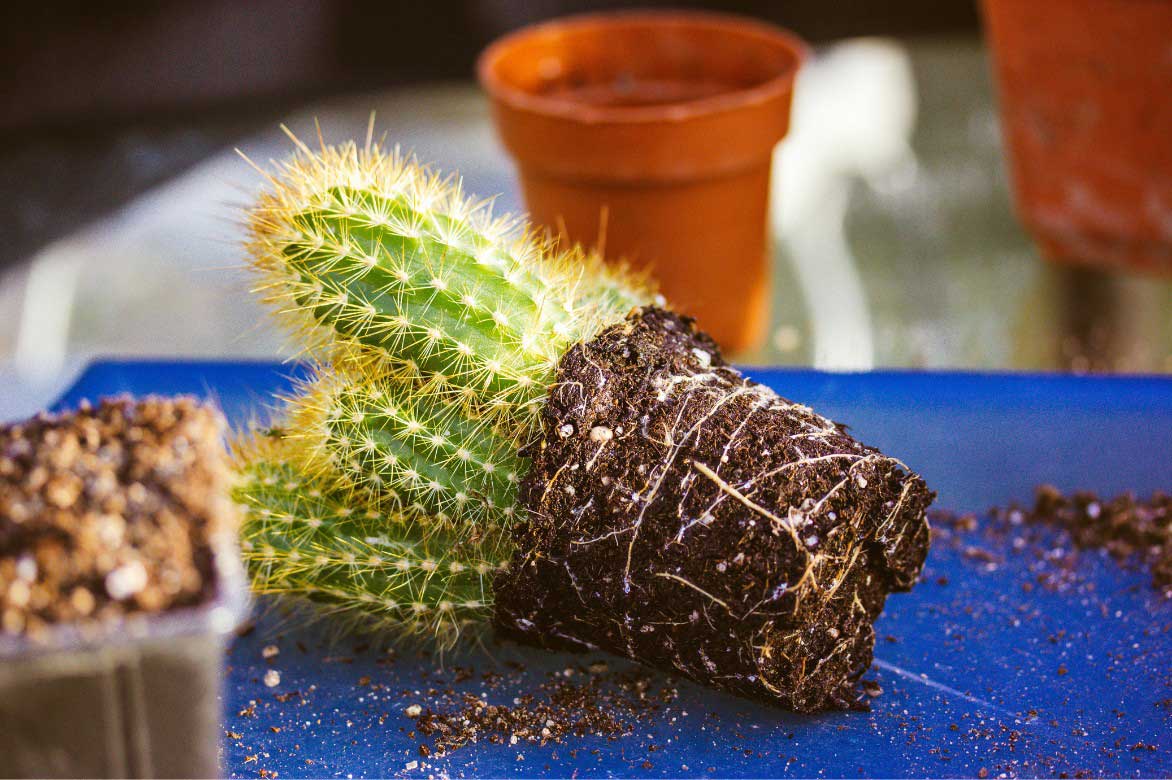
Repot Pilosocereus every two to three years in a slightly larger pot
Diseases and pests of Pilosocereus
Even though it is generally robust, Pilosocereus is not completely free from some health issues. Here are the main problems it may encounter and how to remedy them.
Common Pests
- Mealybugs: These small, cottony white pests often settle at the base of the areoles or along the stems. They suck the sap and weaken the plant. Treatment: Remove mealybugs manually with a cotton swab dipped in 70° alcohol, or use a natural insecticide based on black soap.
- Red spider mites: Less visible to the naked eye, they cause brownish spots or discoloration on the stems. Treatment: Spray a garlic decoction on the plant or prepare a treatment with 20 drops of rosemary essential oil, mixed with a bit of liquid black soap and 5 mL of rapeseed oil. Dilute everything in 1 litre of water and spray on the cactus.
- Aphids: They can appear on young shoots or around flowers. Treatment: Use a solution of diluted black soap in water (15 to 30 g per litre of water) or an insecticide based on plant pyrethrum.
Diseases and Cultivation Problems
The biggest enemy of Pilosocereus is stagnant water!
- Root rot: This occurs when the substrate remains wet for too long. The roots rot, and the base of the plant becomes soft and brown. To avoid this problem, use a well-draining substrate, and never let water stagnate in the saucer. Treatment: Dig up the plant, cut away the rotten parts, and let the roots dry before replanting in a new dry substrate.
- Fungal spots: Appearance of black or brown spots on the stems. Treatment: Remove the affected areas and spray a fungicidal if necessary.
- Etiolation (elongated and pale stem): a sign of lack of light. Move the Pilosocereus to a sunny location, acclimatising it gradually. Don’t hesitate to take it out on your balcony or terrace during the summer!
How to propagate Pilosocereus?
To propagate Pilosocereus, we recommend taking cuttings of its stems, especially if you have a well-established, large plant. It is also possible to propagate it by sowing, but this method requires much more time and patience.
How to take cuttings of Pilosocereus?
This is the most common technique for propagating Pilosocereus, as it allows you to quickly obtain a new plant identical to the parent plant.
- Choose a healthy stem: Cut a straight section about 15 to 30 cm long using clean pruning shears.
- Let it dry: Very important! The cut must heal in the open air for 7 to 15 days, protected from direct sunlight. A crust should form at the base to prevent the risk of rot.
- Plant the cutting: Place it in a pot containing dry, well-draining substrate (cactus mix). Bury the cutting only a few centimetres.
- Water moderately: Wait about ten days before the first watering, then water lightly every two weeks until the first roots appear (approximately 4 to 6 weeks).
How to propagate by sowing?
Sowing allows you to obtain a large number of young plants, but it requires patience.
- Harvest seeds: You can collect seeds directly from the ripe fruits of Pilosocereus or purchase them.
- Prepare the substrate: Use a light, sterilised mix (fine potting soil + sand + perlite).
- Sowing: Sow on the surface and do not bury the seeds, or only very lightly.
- Humidity: Maintain a humid atmosphere (mini-greenhouse or plastic film) and place the pots in light, but out of direct sunlight.
- Germination: This can take 1 to 4 weeks. When the seedlings are a few centimetres tall, they can be transplanted into individual pots.
How to showcase Pilosocereus and which plants to pair it with?
The Pilosocereus is spectacular on its own, but it can also be highlighted in combination with other plants to create an exotic atmosphere. Its tall habit, silver-blue colour, and woolly texture make it an excellent contrasting element in a dry garden display, on a terrace, or indoors.
In a pot, the Pilosocereus becomes a true decorative feature, which can be placed on a sunny terrace or in a conservatory. In large drained containers, it pairs well with other succulents such as sedums or echeverias, which carpet the base of the plant while adding splashes of colour. Crassulas or kalanchoes offer varied textures, while small species like lithops or haworthias create a fun and original scale play at its feet.
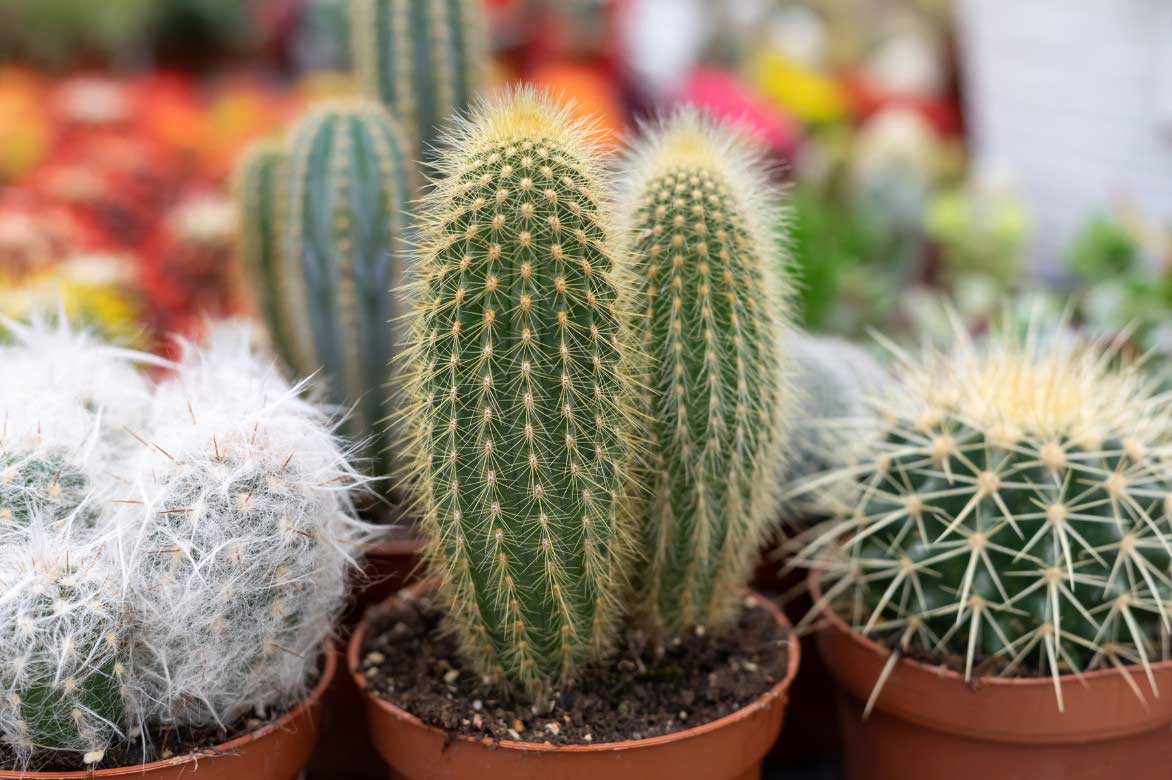
Cephalocereus, Echinocactus and Pilosocereus
In very mild climates, it can be integrated into a rockery, a dry garden, or a Mexican-inspired border. It naturally associates with agaves, whose geometric shapes and sharp foliage contrast effectively with its soft columns. Some aloes add a touch of colour with their orange-red flowers, while opuntias, with their flat pads, enrich the scene with complementary shapes. Xerophytic euphorbias, such as Euphorbia ingens or Euphorbia trigona, enhance the sculptural character of the ensemble, and ornamental grasses, such as stipas or Muhlenbergia, introduce movement and lightness around its rigid silhouette.
To enhance its aesthetic, it is advisable to place it in a raw or glazed terracotta pot, preferably in warm tones – ochre, red, or sand – that contrast beautifully with its bluish colour. Adding white gravel or volcanic stones on the surface creates a strong visual contrast around the base. It is also possible to present it as a solitary feature in a large container for a living sculpture effect, or to combine it with other pots of varying heights to create a dynamic and modern scene.
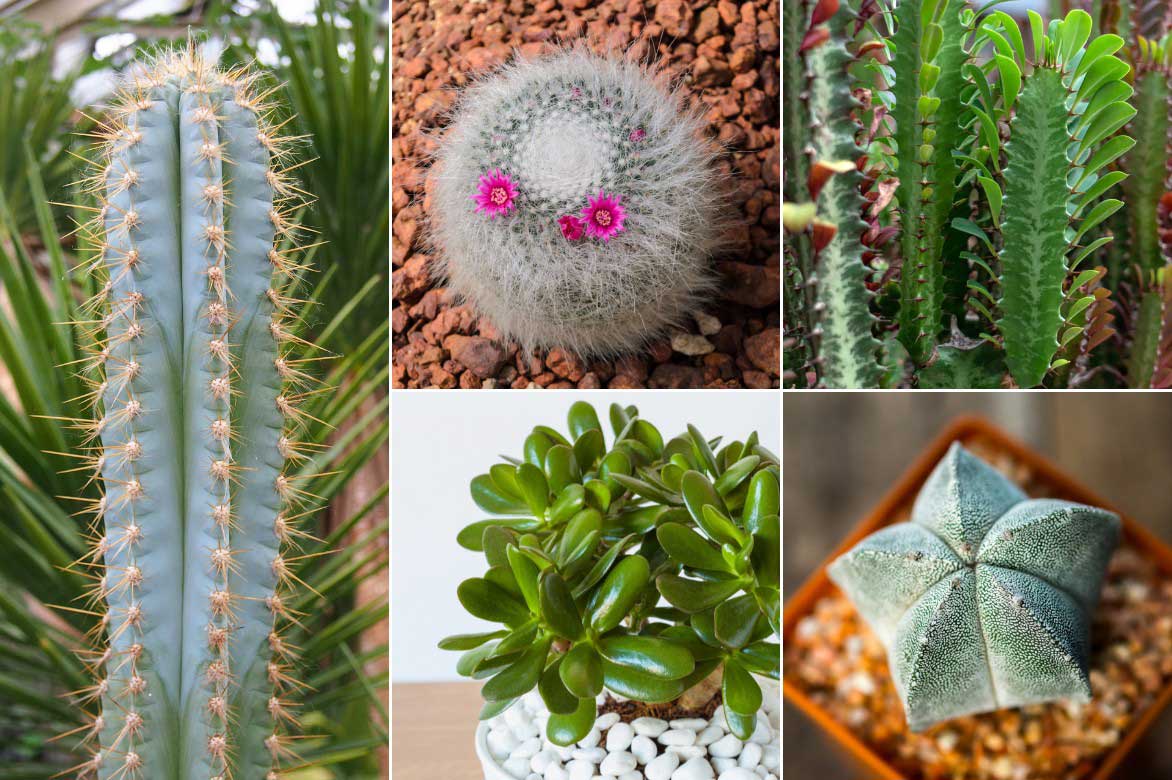
The Pilosocereus benefits from being combined with other cacti and succulents. Pilosocereus pachycladus (photo: Agnieszka Kwiecień), Mammillaria, Euphorbia trigona, Crassula ovata and Astrophytum myriostigma
Also to read
- Discover our entire range of indoor plants, as well as our range of cacti and succulents
- Our books on cacti and succulents
- Subscribe!
- Contents































Comments